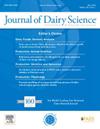产前饲料摄入量的变化幅度:使用多类预测因子进行估算,以及与过渡代谢、健康和产奶量之间的关联。
IF 3.7
1区 农林科学
Q1 AGRICULTURE, DAIRY & ANIMAL SCIENCE
引用次数: 0
摘要
本研究的目的是确定与单独饲喂的 273 头奶牛产前干物质摄入量相对变化(RCDMI)相关的因素,评估使用不同类别的预测因子估算 RCDMI 的线性模型的性能,并描述 RCDMI 对过渡代谢、健康和后续产奶量的影响。确定了两个关注期。时期 1 包括产犊后的第 -21 天至第 -12 天,此时 DMI 保持稳定。第 2 期包括第 4 天至第 1 天,此时平均 DMI 明显下降。从第 1 期到第 2 期的 RCDMI 以百分比值计算,范围在 -75% 到 15% 之间,平均为 -18.1% (±15.0)。季节、胎次、体脂率、体重、上一泌乳期和干奶期的产奶量以及干奶期长与 RCDMI 有关,可解释所有奶牛 11% 的变异,仅考虑奇数奶牛时可解释 19% 的变异。加入反刍和体力活动数据以及目标血液代谢物后,线性模型预测 RCDMI 的性能有所提高。调整后的 R2 值增加到了 0.45 到 0.55 之间,所选模型在交叉验证分析中表现一致。为了评估 RCDMI 的影响,根据 RCDMI 对奶牛进行了同胎排序,并将奶牛分为大衰退 (LD)、中度衰退 (MD) 或小衰退 (SD) 三等分。根据设计,DMI 在第 1 期(13.3 ± 0.2 千克/天)的三等组之间没有差异,但在第 2 期差异很大(LD = 8.8;MD = 11.2;SD = 12.7 ± 0.2 千克/天),造成了各组之间 RCDMI 的重要差异(LD = -33.8;MD = -16.2;SD = -3.4% ± 0.8%)。入学时,LD 组和 MD 组的奶牛体重较大(LD = 788;MD = 775;SD = 750 ± 7 kg),BCS >3.5 的奶牛比例在 LD 组较高(LD = 63;MD = 47;SD = 38%)。在产后 DMI 方面,观察到组别与时间的交互作用,LD 奶牛的 DMI 开始低于 SD 奶牛,但在过渡期结束时相等,并在产犊后第 13 和 14 周出现倒置。LD奶牛的能量校正奶产量高于SD奶牛,且两组奶牛的能量校正奶产量与MD奶牛无差异(LD = 41.0;MD = 40.3;SD = 39.0 ± 0.5 kg/d)。与 SD 奶牛相比,LD 奶牛的能量平衡下降,血清中的非酯化脂肪酸、β-羟基丁酸和天冬氨酸氨基转移酶浓度升高,血浆中的谷胱甘肽过氧化物酶活性升高。产前体重指数的大幅下降也与产后疾病风险的增加有关,尽管这种关联只是微弱到中等程度。总之,产前体重指数的大幅下降与能量代谢和抗氧化剂活性的重要调整以及随后泌乳期更高的产奶量有关。这些研究结果表明,临近分娩时采食量的下降很可能是奶牛自由采食时对泌乳初期生理适应的正常反应。本文章由计算机程序翻译,如有差异,请以英文原文为准。
Magnitude of change in prepartum feed intake: Estimations using multiple classes of predictors and associations with transition metabolism, health, and milk production
The objectives of this study were to identify factors associated with the relative change in prepartum DMI (RCDMI) of 273 cows fed individually, evaluate the performance of linear models to estimate RCDMI using different classes of predictors, and characterize the implications of RCDMI to transition metabolism, health, and subsequent milk production. Two periods of interest were established. Period 1 comprised d −21 to −12 relative to calving, when DMI was stable. Period 2 comprised d −4 to −1, when average DMI was distinctly declined. The RCDMI from period 1 to 2 was calculated as a percentage value, which ranged from −75% to 15% and averaged −18.1% (± 15.0%). Season, parity, body fatness, body weight, milk production in the previous lactation and at dry-off, and length of dry period were associated with RCDMI and explained 11% of the variation in all cows, and 19% when only parous cows were considered. Performance of linear models to predict RCDMI was improved when data on rumination and physical activities and target blood metabolites were added. The adjusted R2 increased to values between 0.45 and 0.55, and selected models performed consistently in cross-validation analyses. To evaluate the implications of RCDMI, cows were ranked within parity according to RCDMI and classified into terciles as large decline (LDec), moderate decline (MDec), or small decline (SDec). By design, DMI did not differ between tercile groups in period 1 (13.3 ± 0.2 kg/d), but differed substantially in period 2 (LDec = 8.8; MDec = 11.2; SDec = 12.7 ± 0.2 kg/d), creating important differences in RCDMI among groups (LDec = −33.8; MDec = −16.2; SDec = −3.4% ± 0.8%). At enrollment, cows in the LDec and MDec groups were heavier (LDec = 788; MDec = 775; SDec = 750 ± 7 kg), and the proportion of cows with BCS >3.5 was higher in LDec (LDec = 63%; MDec = 47%; SDec = 38%). An interaction between group and time was observed for postpartum DMI, which started lower in LDec than in SDec cows, equaled by the end of transition, and inverted at wk 13 and 14 after calving. Yields of ECM were greater in LDec than in SDec cows, and both groups did not differ from MDec (LDec = 41.0; MDec = 40.3; SDec = 39.0 ± 0.5 kg/d). The LDec cows had decreased energy balance and greater concentrations of nonesterified fatty acids, β-hydroxybutyrate, and aspartate aminotransferase in serum, and greater glutathione peroxidase activity in plasma than SDec cows. Larger declines in prepartum DMI were also associated with increased risk for postpartum disease, although the associations were only weak to moderate. In conclusion, a large decline in prepartum DMI of cows fed ad libitum was associated with important adjustments in the energy metabolism and antioxidants activities, and greater milk production in the subsequent lactation. These findings indicate that feed intake decline close to parturition is likely a normal response to physiological adaptations at the onset of lactation when cows are fed ad libitum.
求助全文
通过发布文献求助,成功后即可免费获取论文全文。
去求助
来源期刊

Journal of Dairy Science
农林科学-奶制品与动物科学
CiteScore
7.90
自引率
17.10%
发文量
784
审稿时长
4.2 months
期刊介绍:
The official journal of the American Dairy Science Association®, Journal of Dairy Science® (JDS) is the leading peer-reviewed general dairy research journal in the world. JDS readers represent education, industry, and government agencies in more than 70 countries with interests in biochemistry, breeding, economics, engineering, environment, food science, genetics, microbiology, nutrition, pathology, physiology, processing, public health, quality assurance, and sanitation.
 求助内容:
求助内容: 应助结果提醒方式:
应助结果提醒方式:


